Dover Corporation Tramways
History
Dover was notable for building the first electric street tramway in the south of England, preceding the first in London by four years. Its beginnings stem back to the 9th November 1895, when Dover Town Council elected to build a tramway in the town, though at the time they had still not decided what mode of traction they would use. The resulting Dover Corporation Tramways Provisional Order received its Royal Assent on the 20th July 1896, at which time the council commissioned a report into the various options, ultimately deciding on overhead electric traction. It is unclear when work began, but it was certainly underway in April 1897, and had possibly commenced several months prior to that.
The 3ft 6ins-gauge tramway was opened to the public on the 6th September 1897, the initial services running from Buckland through to the London Chatham and Dover Railway Company's Harbour Station. A branch line along Folkestone Road to Maxton was opened at the end of December 1897, with a small extension of the main line, to Beach Street near the South Eastern Railway Company's Dover Town Station, opening in early 1898. The latter included a level crossing, which quickly caused havoc with timetabling, as the crossing gates were frequently closed against road traffic (including the trams) to facilitate shunting; as a result, services over the extension only lasted a matter of months before being cut back to Cross Wall.
The tramway commenced services with eight tramcars and two trailers, and was an immediate success, such that the two trailers were quickly motorised (in 1898), and six new vehicles were ordered, these being delivered in 1898 and 1899. Following a poll, the corporation decided not to run Sunday services, so the entire fleet lay unused for one day in every seven, a decision which took thirteen years to reverse, trams finally running on Sundays from March 1911.
Meanwhile, the corporation took over powers for an extension of the tramway from Buckland to River (to the northwest of the town); these powers had been granted to the Dover and River Light Railways Syndicate — a group of mostly local luminaries and speculators — on the 12th October 1903. Work commenced on the extension on the 20th February 1905, the first services over the new line running on the 2nd October 1905.
The River extension took the system to its final size of 4.29 miles. From the northern terminus in River — at the junction of Minnis Lane and Lewisham Rd — the tramway's main line ran roughly southeastwards along Lewisham Road (the southern half of which was then a tram-only reservation), before winding along Crabble Road and descending Crabble Hill to Buckland, where the main depot was located. From here the line continued southeastwards along London Road, High Street, Biggin Street and Cannon Street to the Market Place, which it exited southwards via King Street and Bench Street, before turning southwestwards along the harbour front, via Northampton Street, Snargate Street and Strond Street to a terminus at Cross Wall. The branch line ran westwards from a junction with the main line in Biggin Street, through Priory Place and along Folkestone Road to Maxton, where a second depot was located, just short of the terminus, which was outside the Orange Tree public house.
The tramcar fleet was supplemented by an additional car in 1902, with another four being added in 1905 to work the services to River.
Unfortunately, the corporation had elected not to build up a renewals fund, instead using the profits from the tramway to subsidise the rates, blithely expecting to receive approval for a loan when the time came. The system was therefore allowed to slowly decay, and though another tramcar was added in 1912, by 1913 the lightly engineered track, most of which was sixteen years old, was in extremely poor condition. The corporation eventually decided to bite the bullet, only for the Great War to intervene, new track then being extremely difficult to obtain (it needed government approval). Dover therefore not only suffered from loss of staff and skills (to the armed services), and greatly reduced maintenance, but unlike most other systems, also had to cope with track that ought to have been replaced years earlier. The worst offending sections were relaid with rail obtained by robbing one of the tracks on the River extension, which had, unlike the rest of the system, been built as a double-track formation. The war was also indirectly responsible for the deaths of eleven passengers when a tramcar got out of control descending Crabble Hill, the accident being ascribed to the inexperience of the motorman. By the end of the war, services had been greatly reduced, not only due to staff shortages, but also an acute shortage of serviceable tramcars.
A new manager was appointed in 1918, and one of his first acts was to commission a report on the condition of the tramway, which must have made for pretty sobering reading in the council offices, as it all-but condemned the system; not only were the rails and overhead wiring in appalling condition, but over half the tramcars were out of service, many of them having presumably been cannibalised to keep the remainder running. The council finally decided to invest in the system, though it had little choice other than closure; three new tramcars arrived in 1920, a year which also saw complete replacement of the overhead wiring, as well as substantial, though not complete, track renewals. The council did, however, refuse the request of the tramway manager for the track to be brought under his control, track maintenance remaining in the hands of the borough engineer, a situation that almost certainly contributed to the poor state of the track, the latter having different priorities.
After years of talking about building an elevated roadway (i.e., a viaduct) across the harbour railway lines to the town's new joint Marine Railway Station (opened in 1916), this was finally completed in 1921/1922. The council, however, baulked at the cost of extending the tramway across it, both in 1922 and again in 1924. The stated cost was indeed extraordinarily high for such a short section of tramway, perhaps suspiciously so. The council now explored scrapping the harbour front tramway and replacing it with either motorbuses or trolleybuses, a proposal that was soon dropped in the face of concerted local opposition.
The tramway was now destined to be operated on a make-do-and-mend basis, track renewal only taking place grudgingly (usually after a couple of years of deferral), and tramcar replacement only extending to rebuilding existing cars and the purchase of cheap, but already old second-hand vehicles, rather than new, modern tramcars. Secondhand vehicles arrived in 1926 (two from Darlington Corporation Light Railways), 1927 (five from West Hartlepool Corporation Tramways), 1928 (two tramcars and three top covers from the Birmingham and Midland Tramways Joint Committee), 1930 (another five tramcars from the B&MTJComm), and finally in 1933 (two cars and two bodies from Birmingham Corporation Tramways).
Throughout the 1920s and 1930s, the council could not reach agreement on what form its future transport provision should take, many individuals still pushing hard for motorbuses and trolleybuses. The indecision was suddenly brought into sharpened focus in April 1934 when the East Kent Road Car Company offered to run motorbus services in the town. The initial approach was turned down by the Tramways Committee in favour of promoting a bill to enable the running of motorbuses, i.e., to continue municipal operation, but with another mode of traction. However, the full council had other ideas, and commissioned a report from the General Manager of Birmingham Corporation Tramways that covered three scenarios: 1), tramway modernisation; 2), replacement by EKRCCo motorbuses; 3), replacement by corporation motorbuses.
In November 1934, the council empowered the Birmingham Manager to negotiate directly with the EKRCCo, the upshot of which was that agreement was reached for the trams to be replaced by EKRCCo motorbuses, the council thereafter receiving a proportion of the fares and profits.
The last Dover Corporation Tramways service duly ran, as agreed, on the 31st December 1936.
Uniforms
Tramcar crews were initially issued with smart double-breasted jackets with four closely spaced pairs of buttons — presumably brass (see link) — and lapels; the collars carried an oval cloth badge with embroidered lettering and an employee number. Caps were in a kepi style with a glossy peak and appear to have carried a script-lettering badge, probably the bearer's grade, and more than likely, embroidered. At some point, probably in the Edwardian era, a switch was made to a more modern tensioned-crown design of peaked cap; these carried a hat band with embroidered lettering. Two variations were used, one with a single row of script lettering ('Tramway Conductor' or 'Tramway Driver') and the other with two rows of block capitals (either 'TRAMWAY CONDUCTOR' or 'TRAMWAY DRIVER'). It is likely that the script-lettering variety came first, though both styles were certainly in use at the same time when the 1921 staff photo shown below was taken.
Over the years, the basic style of the uniform changed little, save for slight alterations to the cut as fashions changed. Jackets remained double-breasted with closely spaced buttons, but with a fifth pair added between the lapels and collars at some point. The cloth badge on the collars was dispensed with relatively early on (probably in the late-Edwardian era), being superseded by individual brass employee numbers. Later photographs clearly show that conductors and motormen were numbered separately, such that duplicate numbers existed, one assigned to a conductor and the other to a motorman.
Tramcar crews were also issued with double-breasted greatcoats with five pairs buttons, the collars of which appear to have carried the same insignia as used on the jackets.
The 1921 staff photo below reveals that Dover employed the services of the following senior staff: a checker, two inspectors and an acting-inspector. All three wore identical jackets to the tramcar crews, but without employee numbers. The checker's collars were left plain, whereas inspectors' collars bore an oval cloth badge containing the grade — 'Inspector' — in embroidered script lettering. The caps probably initially bore a very similar badge to the collar badge, though slightly larger, but were superseded by hat bands with embroidered block capitals, 'TRAMWAY CHECKER' and 'TRAMWAY INSPECTOR' over two lines.
Like many tramway systems, Dover suffered from a loss of male staff to the armed forces during the Great War, eventually responding to this by taking on conductresses. The only surviving photo of a Great War conductress in a uniform jacket and skirt, rather than a long topcoat, is unfortunately of poor quality (see below), though it does show the jackets to have been single-breasted with a waist belt (with button fastening) and lapels. It is currently unclear what insignia these jackets bore. The long topcoats worn over the jackets were double-breasted with six pairs buttons and high fold-over collars; the latter carried the designation 'TRAMWAY CONDUCTOR' — in embroidered block capitals — above an employee number. Headgear took the form of a wide-brimmed, dark-coloured straw bonnet — possibly for summer wear — which appears not to have carried any insignia, but instead was sometimes adorned with bows or rosettes, presumably of the ladies' own making. One photo suggests that more robust cloth caps/bonnets were also issued, presumably for winter use.
Further reading
For a history of the system, see: 'Dovers Corporation Tramways, 1897-1936' by J V Horn; The Light Railway Transport League (1955).
Images
Motormen and conductors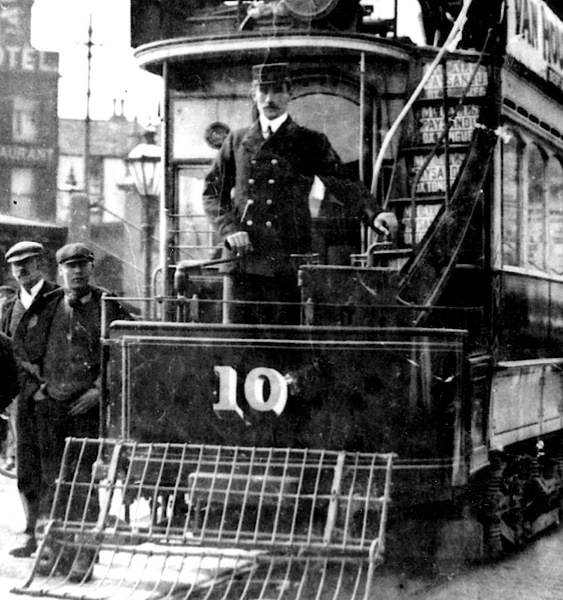
A motorman at the controls of Tramcar No 10 near the Royal Hotel — photo undated, but probably taken around the turn of the century after No 10 had been motorised (it was originally supplied as a trailer). His kepi-style cap appears to bear a script-lettering badge, probably embroidered. With thanks to Ray Woodmore.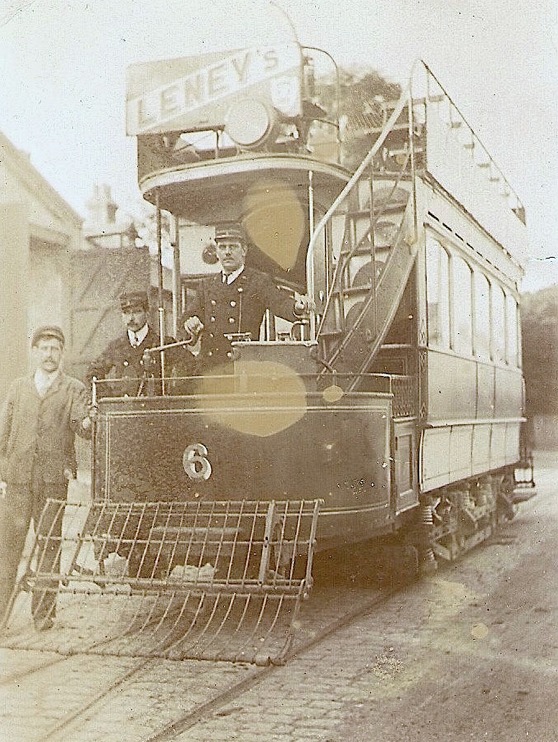
A fitter, a conductor and a motorman pictured with Tramcar No 6 outside Maxton depot around the turn of the century. Both men are wearing kepi-style caps with what appears to be a single line of script lettering, very probably an embroidered grade badge. Source unknown.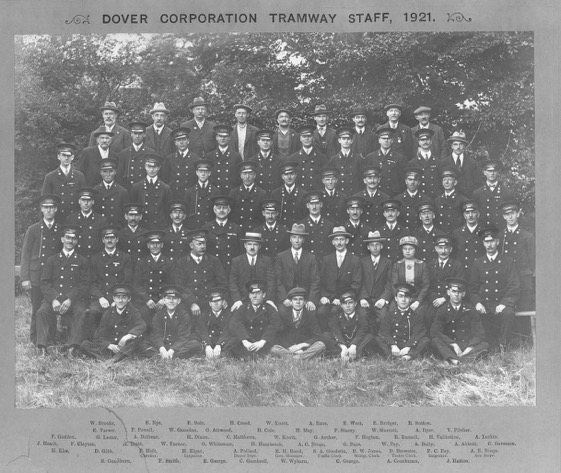
A wonderful and rare staff photo by any system's standard, of what is probably the entire Dover Corporation Tramways Department, all named, and taken in 1921. As far as uniformed staff are concerned, there are 12 conductors, 28 motormen (called drivers in Dover), 1 checker, 2 inspectors and 1 acting-inspector. Some of the non-uniformed staff are probably the missing conductors. Author's Collection.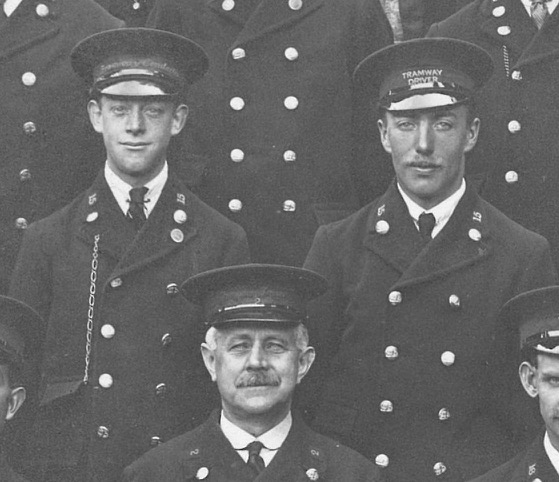
An enlargement of the above photograph showing Conductor No 15 (H Dixon) and Motorman No 15 (C Matthews), showing that the same employee numbers were issued to each grade, so were in effect duplicated.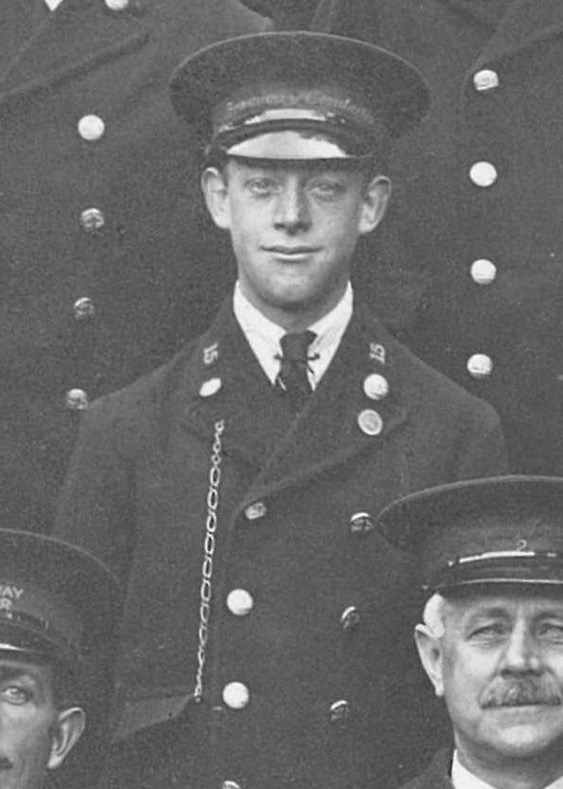
Conductor No 15 (H Dixon). His hat band bears his grade — 'Tramway Conductor' — in embroidered script lettering rather than block capitals, the latter style being in the overwhelming majority.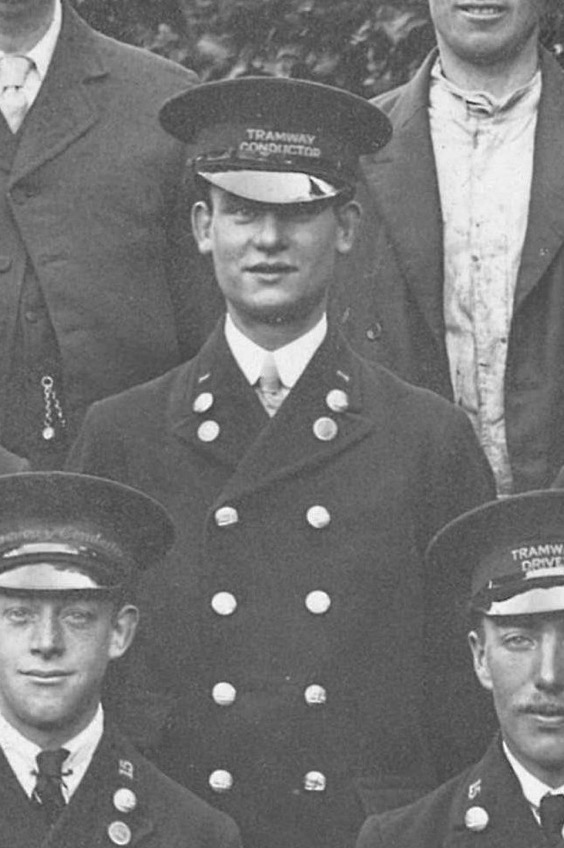
Another blow-up of the staff photograph above showing Conductor No 1 (G Attwood). His collars carry his number, whilst his cap bears a hat band with his grade — 'TRAMWAY CONDUCTOR' — in embroidered, block capitals.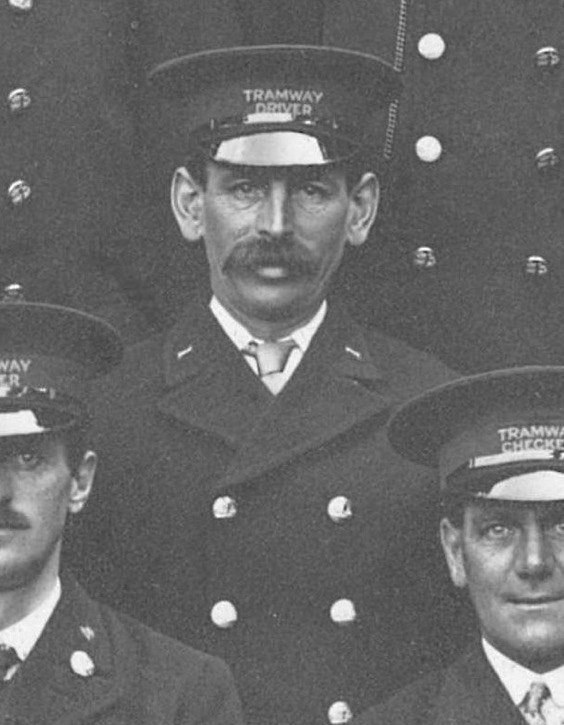
Another enlargement of the staff photograph above showing Motorman No 1 (H Brett). His hat band bears his grade — 'TRAMWAY DRIVER' — in embroidered block capitals.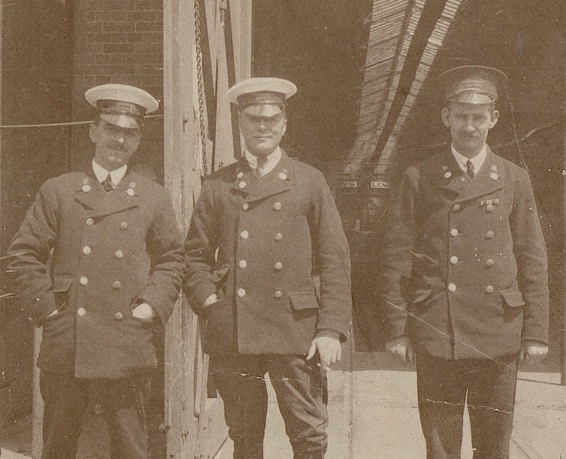
Motorman 13 (A Dyer), 5 (?) and 16 (H Hambrook), pose for the cameraman outside Buckland Depot — photo undated, but probably taken in the mid 1920s. Author's Collection. 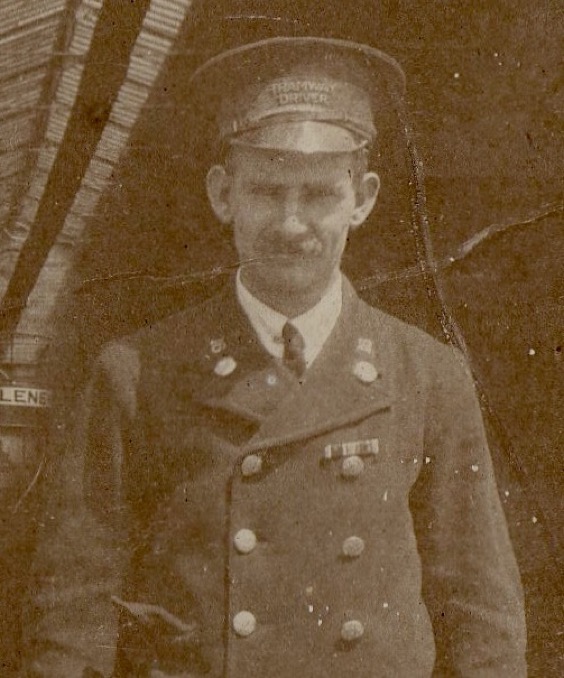
An enlargement of the above photograph, showing Motorman Hambrook; the top buttons clearly sat between the lapels and the collars.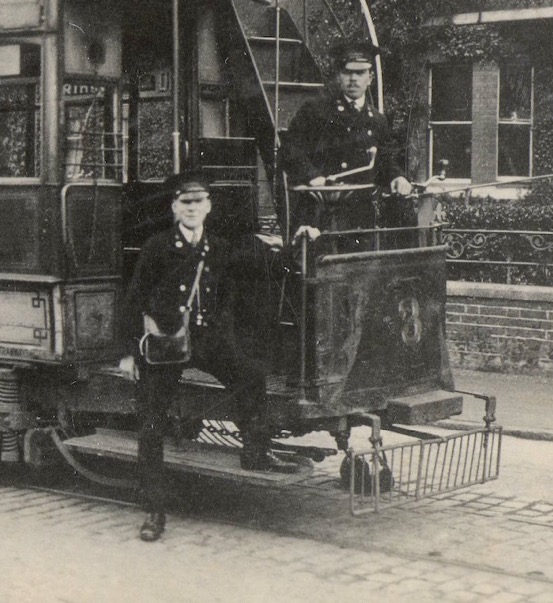
The crew of a sadly dilapidated No 3 pose for the cameraman — photo undated, but in view of the poor condition of the vehicle, which was scrapped in 1927, probably taken not too long before then. Author's Collection.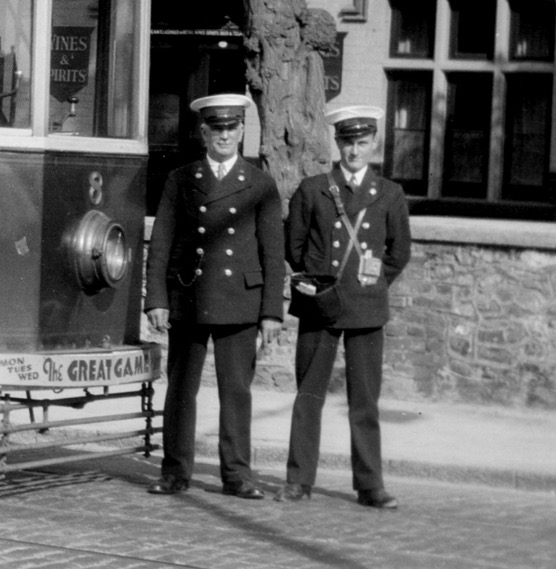
A motorman and a conductor with Tramcar No 8 at or near the Maxton terminus in 1926, the year this car was acquired from Darlington Corporation Light Railways. Photo possibly by H Nicol, courtesy of the National Tramway Museum. 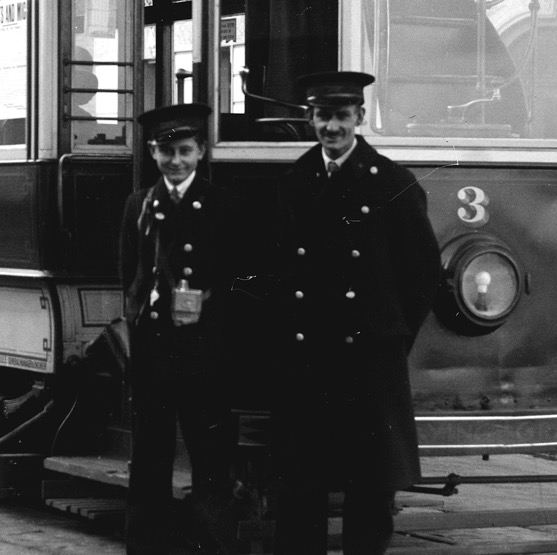
A very youthful-looking conductor and his motorman (possibly H Hambrook), with Tramcar No 3 outside the Swan Hotel with a service for Buckland — photo undated, but definitely taken after 1927 when this car was acquired from West Hartlepool Corporation Tramways. Photo courtesy of the National Tramway Museum.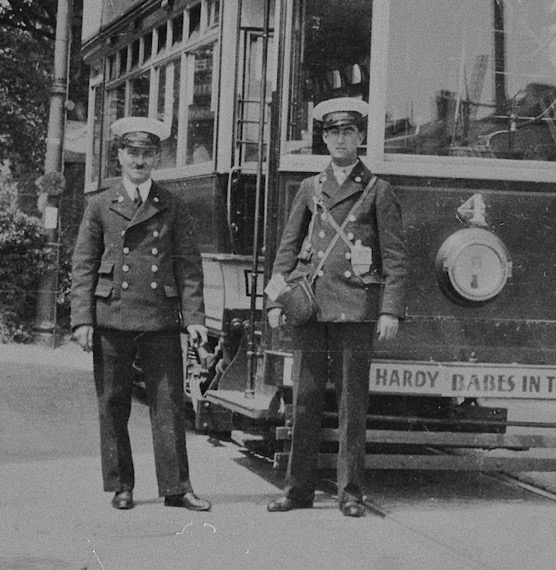
A motorman and a conductor pose for the cameraman at the terminus of the River route with Tramcar No 4 in 1935. Photo courtesy of the National Tramway Museum.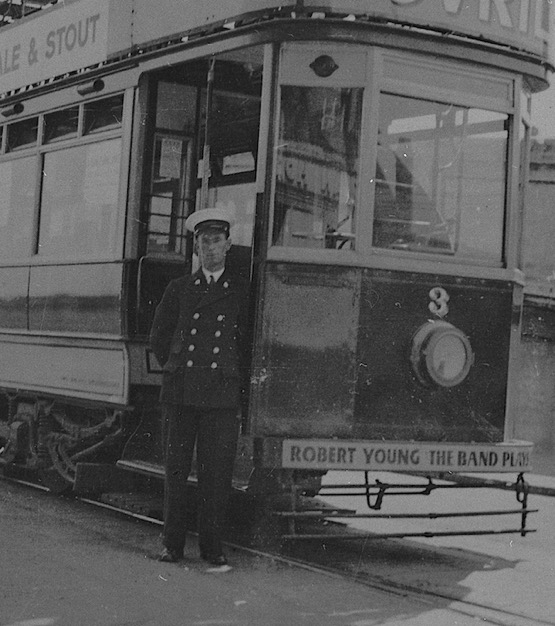
A motorman with Tramcar No 3 (an ex-Hartlepool vehicle) at the Pier terminus in 1935. Photo courtesy of the National Tramway Museum.
Senior staff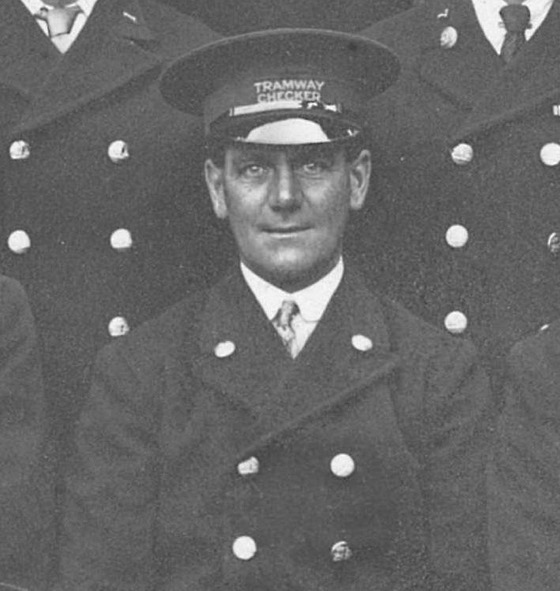
An enlargement of the 1921 staff photograph above showing F Holt, who was a checker. Apart from the absence of an employee number on his collars and his hat band — 'TRAMWAY CHECKER' — the uniform is identical to those worn by conductors and motormen.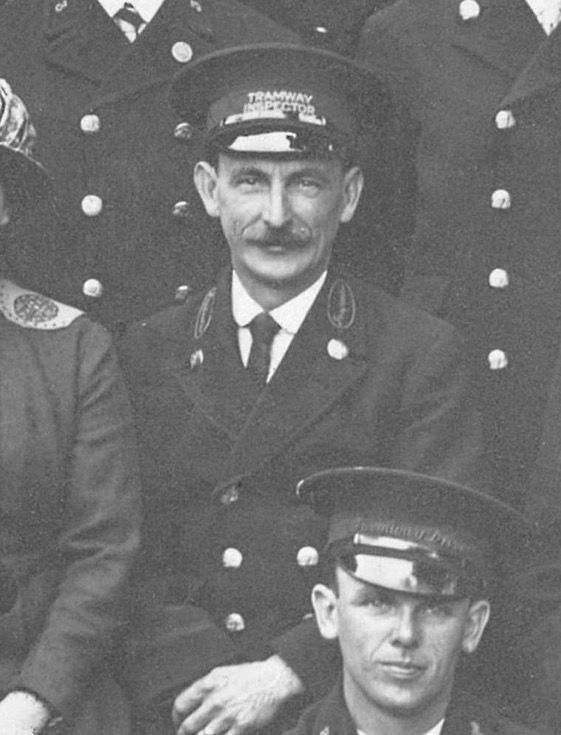
Another blow-up of the 1921 staff photograph, this time showing Inspector F Pay. His collars bear an oval cloth badge containing his grade — 'Inspector' — in embroidered script lettering, whilst his cap bears the standard hat band with block capitals, 'TRAMWAY INSPECTOR'.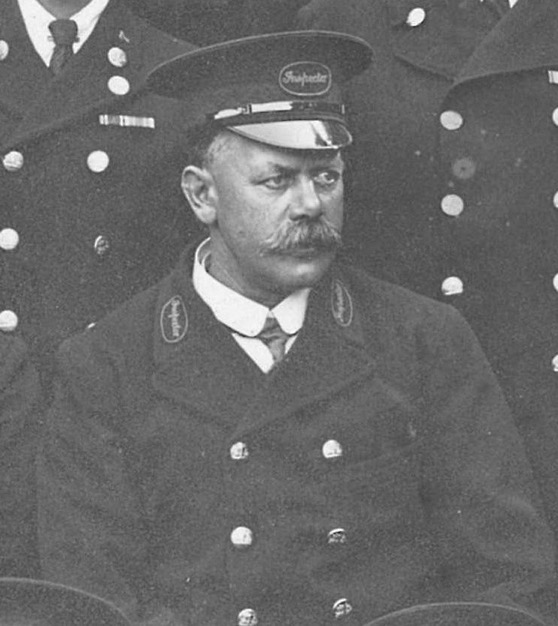
Yet another blow-up of the 1921 staff photograph, this time showing Inspector H Elgar. In contrast to Inspector Pay, he has an oval cloth cap badge containing his grade — 'Inspector' — in embroidered script lettering. This is probably an older style of badge, the block-capitals variety likely superseding it.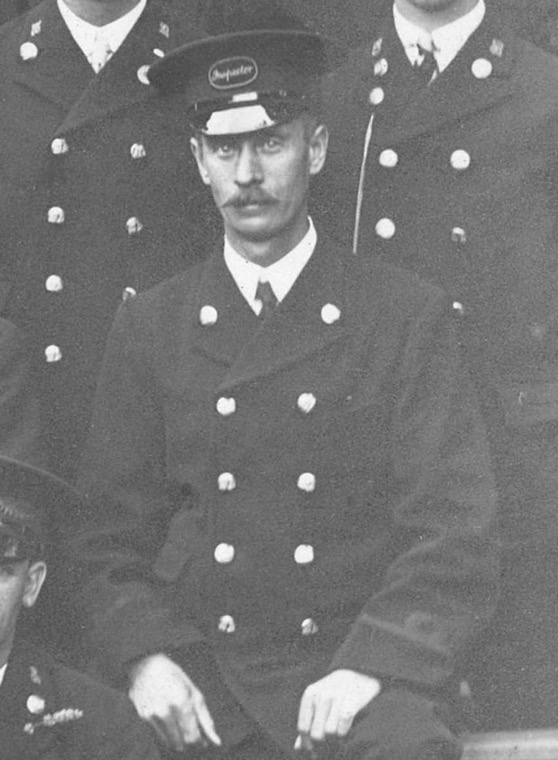
Acting-inspector A E Binge. His collars have no employee numbers or grade badges, but his cap does bear the old style of inspector's cap badge.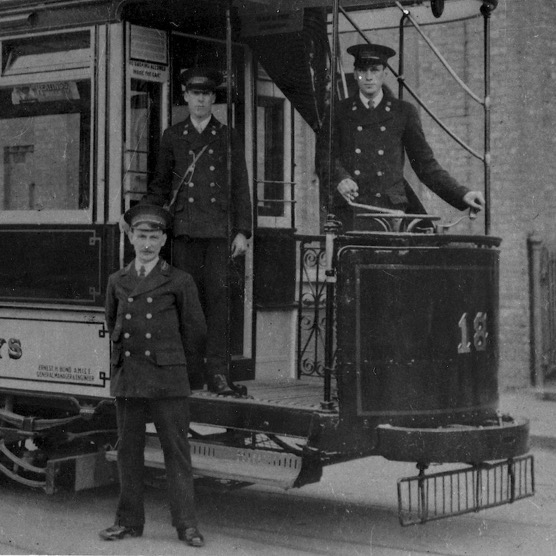
Chief Inspector Pay, who had clearly been promoted since 1921, when he is listed is an inspector. The shot is taken at Buckland with what appears to be a newly outshopped Tramcar No 18 — photo undated, but certainly taken between 1921 (the year the staff photo was taken) and 1923 when this car was purportedly withdrawn. Author's Collection.
Female staff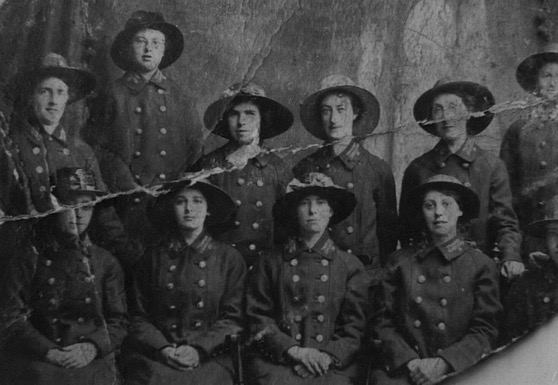
A studio shot of eleven Dover conductresses — photo undated, but almost certainly taken during the Great War. The lady on the back row at the extreme left is Mrs Clare Kelby, whilst the lady standing next to her is a Mrs Brewster. Photo courtesy of David Burridge.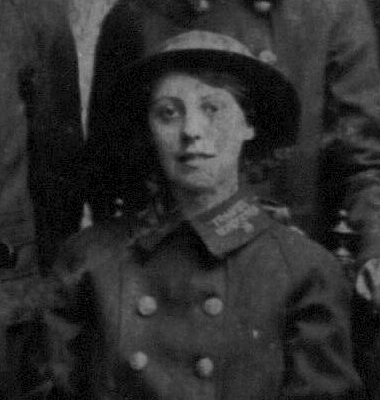
An enlargement of the above photograph showing one of the conductresses. Her overcoat collars carry the designation 'TRAMWAY CONDUCTOR', along with an employee number, all embroidered. Photo courtesy of David Burridge.
A conductress and a motorman aboard Tramcar No 23 — photo undated, but almost certainly taken during the Great War. Source unknown.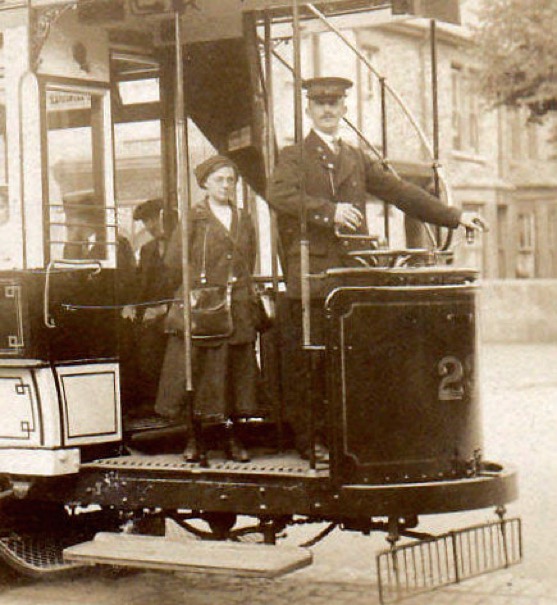
A blow-up of the above photograph, which reveals the conductress to be wearing a tailored, single-breasted jacket with lapels.